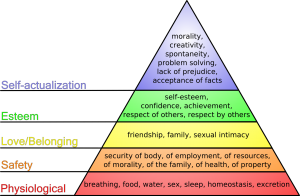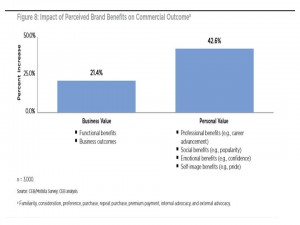Underlying every business decision is a personal need – a human need. It’s Abraham Maslow’s famous Hierarchy of Needs in action. Customers don’t make purely rational, logical decisions. Although for too long, B2B marketers acted as if customers made robotic decisions based solely on rational value. We don’t check our human cards at the door when we go to work for an employer! This is a topic I’ve written about for years and I’m as passionate about it as ever. (Note: You can download my ebook on how to create a more human case study).
Why? Because until businesses remember this, their marketing, their value propositions – all of it – is wasted effort focused on the wrong things. Yes, the logical or rational value matters; yet, the personal and emotional value for the buyer always matters more. Always. While technology and tools change, people don’t. People have human needs for belonging, attachment, peer recognition, stability, risk reduction, visibility, freedom, security…the list goes on and on! Yep, we’re people first; business buyers, second.
Personal, Emotional Value Matters
Business value boosts consideration. However, it does not create sustainable differentiation. By contrast, personal value does. People – human beings – not businesses make B2B purchasing decisions. And the buyer(s) will always ask, “What’s in it for me professionally and personally?” That human filter for making decisions is the most important filter you have to appeal to in order to win the war on commoditization, and it’s a war CMOs are all too familiar with.
Making the emotional connection to personal value in B2B is the secret sauce. Research now illustrates exactly how important emotional value based on a personal, human need really is. Of course, as marketers we already knew it anecdotally, right? For those that need proof, here you go!
The CMO War on Commoditization Means Winning Hearts
In a 2013 study, The Corporate Executive Board (CEB) Marketing Leadership Council in partnership with Google found that personal value and social value (perceived by peer group) had twice the effect on commercial purchasing outcomes (purchasing, consideration, advocacy, etc.) as business value.
That means emotions trump logic every day of the week when it comes to outcomes. Buying always involves personal, human risk. Your differentiation story must take this into account.
For example, that marketing VP you sell to: How will your services make her look good to her boss and build her internal reputation? How will your IT services mitigate the CIO’s professional and personal risk? And that CFO you sell business insurance to isn’t concerned exclusively with the corporate bottom line – it’s his own bottom line he’s worried about! Remember the old adage, “No one ever got fired for buying IBM?” That speaks volumes to the human need for security and risk-mitigation for the business AND for the buyer personally. For some audiences, there is tremendous personal and social value in being the “first to know and use” new technology. Your story must speak to those critical and very human needs of your ideal audience.
Create Emotional Value: Speak to Personal Needs and Stand Out
The story you tell about your product and service value must go beyond pure quantitative economic and productivity value. It must address the personal value your products and services create for your prospects and customers. This is where most products get stuck – no B2B buyer makes rational decisions for the good of the organization in a hermetically-sealed environment without regard for his or her personal needs.
Moreover, research also shows that emotional content is the most shared of all content; more specifically, content that makes people look good and feel good (makes them happy) gets shared the most. In fact, campaigns with purely emotional content performed almost twice as well (31% vs. 16%) as those with only rational content (neurosciencemarketing.com).
Pack a One-Two Punch with Emphasis on The Personal
Your story must pack a one-two punch if it is to win the battle for sustainable differentiation. Beyond rational value, your story must speak to:
- How you make customers’ personal lives better, easier, simpler (read: reduced complexity)
- What customers can do because of your offerings that they couldn’t do before
- How your product improves buyers’ emotional or professional well-being
- How your product or service enhances buyers’ reputation / visibility, and/or reduces personal risk
- How your product or service creates social/peer value (if relevant)
You can download my ebook on how to create a more human case study
All Business is Personal Because All Risk Is
Every organization, therefore, is in the simplification and risk-reduction business as well as in the personal business. It is your job to make your customer look good to his or her organization, and that means you needs to talk to how you will reduce your customers’ personal risk, in addition to mitigating their business risk. When a customer looks good, both the organization and your customer win. When things go wrong, your customer takes the personal credibility hit. It’s marketing’s job to speak to that personal concern in a meaningful way.
After all, people – not organizations – buy products and services.
So how do you create and communicate personal, human value in your marketing? Let me know – leave a comment!




